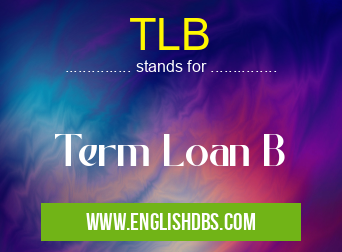What does TLB mean in UNCLASSIFIED
TLB stands for Term Loan B, a type of loan facility commonly used in leveraged buyouts and other complex financial transactions. TLBs are typically provided by a group of banks or other lenders and are secured by the assets of the borrowing company.

TLB meaning in Unclassified in Miscellaneous
TLB mostly used in an acronym Unclassified in Category Miscellaneous that means Term Loan B
Shorthand: TLB,
Full Form: Term Loan B
For more information of "Term Loan B", see the section below.
Characteristics of TLBs
- Seniority: TLBs are typically senior to other forms of debt, such as unsecured loans or bonds. This means that TLB lenders have a higher claim on the borrower's assets in the event of a default.
- Maturity: TLBs typically have maturities of 5-7 years, although they can be longer or shorter depending on the specific transaction.
- Interest rate: TLBs typically have floating interest rates that are tied to a benchmark rate, such as LIBOR or the prime rate.
- Covenants: TLBs often include financial and operational covenants that the borrower must comply with. These covenants are designed to protect the lenders and ensure that the borrower maintains a sound financial condition.
Uses of TLBs
TLBs are used for a variety of purposes, including:
- Leveraged buyouts
- Refinancing existing debt
- Funding acquisitions
- Providing working capital
Advantages of TLBs
- Flexibility: TLBs can be tailored to the specific needs of the borrower, including the amount, maturity, and interest rate.
- Seniority: TLBs provide lenders with a senior claim on the borrower's assets, which reduces the risk of loss in the event of a default.
- Cost: TLBs can be a relatively cost-effective source of financing, especially compared to other forms of secured debt.
Disadvantages of TLBs
- Covenants: TLBs often include restrictive covenants that can limit the borrower's flexibility and make it difficult to operate the business.
- Interest rate risk: TLBs typically have floating interest rates, which exposes the borrower to the risk of rising interest rates.
- Repayment risk: TLBs must be repaid in full at maturity, which can put a strain on the borrower's cash flow.
Essential Questions and Answers on Term Loan B in "MISCELLANEOUS»UNFILED"
What is a Term Loan B (TLB)?
A Term Loan B (TLB) is a type of loan that is typically used to finance leveraged buyouts (LBOs) and other high-risk transactions. TLBs are typically secured by the assets of the borrower and have a higher interest rate than other types of loans.
What are the risks of investing in a TLB?
The risks of investing in a TLB include:
- The borrower may default on the loan, which could result in a loss of principal and interest.
- The value of the collateral securing the loan may decline, which could also result in a loss of principal and interest.
- The interest rate on the loan may increase, which could reduce the value of the investment.
What are the benefits of investing in a TLB?
The benefits of investing in a TLB include:
- TLBs typically offer a higher interest rate than other types of loans.
- TLBs are often secured by the assets of the borrower, which provides some protection against loss in the event of a default.
- TLBs can be used to finance a variety of transactions, including LBOs and other high-risk ventures.
Final Words: TLBs are a versatile and widely used type of loan facility that can provide borrowers with a flexible and cost-effective source of financing. However, it is important to carefully consider the potential advantages and disadvantages before entering into a TLB.
TLB also stands for: |
|
| All stands for TLB |
